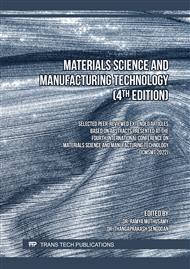[1]
R.T. Loto and P. Babalola: Corrosion polarization behavior and microstructural analysis of AA1070 aluminium silicon carbide matrix composites in acid chloride concentrations Cogent Eng. Vol. 4(1) (2017), p.1422229. http://doi.org/10.1080/23311916.2017.1422229.
DOI: 10.1080/23311916.2017.1422229
Google Scholar
[2]
J. Kruger and S. Begum: Corrosion of Metals: Overview, Reference Module in Materials Science and Materials Engineering (Elsevier, Amsterdam 2016).
DOI: 10.1016/b978-0-12-803581-8.02708-9
Google Scholar
[3]
B.S. Syrett: Cost of Corrosion in the Electric Power Industry EPRI Report 1004662 (2002).
Google Scholar
[4]
G.H. Koch, M.P.H. Brongers, N.G. Thompson, Y. Paul Virmani and J.H. Payer: Corrosion Costs and Preventive Strategies in the United States Mats. Perform. (2002), pp.4-9.
Google Scholar
[5]
G.H. Koch: Cost of corrosion, Trends in Oil and Gas Corrosion Research and Technologies, Production and Transmission (Elsevier, Amsterdam 2017) Chapter 1, pp.3-30.
Google Scholar
[6]
Z. Ahmad: Selection of materials for corrosive environment, Principles of Corrosion Engineering and Corrosion Control (Elsevier, Amsterdam 2006) Chapter 9, pp.479-549.
DOI: 10.1016/b978-075065924-6/50010-6
Google Scholar
[7]
W. Renpu: Oil and Gas Well Corrosion and Corrosion Prevention, Advanced Well Completion Engineering (Elsevier, Amsterdam, 2011) Chapter 1, pp.617-700.
DOI: 10.1016/b978-0-12-385868-9.00018-x
Google Scholar
[8]
B.N. Popov: Corrosion Inhibitors, Corrosion Engineering Principles and Solved Problems, (Elsevier, Amsterdam 2015) Chapter 14, pp.581-597.
Google Scholar
[9]
W.P. Singh and J.O. Bockris: Toxicity Issues of Organic Corrosion Inhibitors: Applications of QSAR Model (NACE International, Texas 1996).
Google Scholar
[10]
B.E. Brycki, I.H. Kowalczyk, A. Szulc, O. Kaczerewska and M. Pakiet, Organic Corrosion Inhibitors IntechOpen (2017).
DOI: 10.5772/intechopen.72943
Google Scholar
[11]
Y. Li, P. Zhao, Q. Liang and B. Hou: Berberine as a natural source inhibitor for mild steel in 1 M H2SO4 Appl. Surf. Sci. Vol. 252 (2005), pp.1245-1253.
DOI: 10.1016/j.apsusc.2005.02.094
Google Scholar
[12]
G. Quartarone, L. Ronchin, A. Vavasori, C. Tortato and L. Bonaldo: Inhibitive action of gramine towards corrosion of mild steel in deaerated 1.0 M hydrochloric acid solutions Corros. Sci. Vol. 64 (2012), pp.82-89.
DOI: 10.1016/j.corsci.2012.07.008
Google Scholar
[13]
H. Ashassi-Sorkhabi, M.R. Majidi and K. Seyyedi, Investigation of inhibition effect of some amino acids against steel corrosion in HCl solution Appl. Surf. Sci. Vol. 225 (2004), pp.176-185.
DOI: 10.1016/j.apsusc.2003.10.007
Google Scholar
[14]
M. ÖZcan: AC impedance measurements of cysteine adsorption at mild steel/sulphuric acid interface as corrosion inhibitor J. Solid State Electrochem. Vol. 12 (2008), pp.1653-1661.
DOI: 10.1007/s10008-008-0551-1
Google Scholar
[15]
R.T. Loto and E. Oghenerukewe: Inhibition studies of rosmarinus officinalis on the pitting corrosion resistance 439LL ferritic stainless steel in dilute sulphuric acid Orient. J. Chem. Vol. 32(5) (2016), pp.2813-2832.
DOI: 10.13005/ojc/320557
Google Scholar
[16]
J. Fu, S. Li, L. Cao, Y. Wang, L. Yan and L. Lu: L-Tryptophan as green corrosion inhibitor for low carbon steel in hydrochloric acid solution J. Mater. Sci. Vol. 45 (2010), pp.979-986.
DOI: 10.1007/s10853-009-4028-0
Google Scholar
[17]
A. Bouoidina, M. Chaouch, A. Abdellaoui, A. Lahkimi, B. Hammouti, F. El-Hajjaji, M. Taleb, and A. Nahle: Essential oil of Foeniculum vulgare,: Antioxidant and corrosion inhibitor on mild steel immersed in hydrochloric medium Anti-Corros. Method M. Vol. 64(5) (2017), pp.563-572.
DOI: 10.1108/acmm-10-2016-1716
Google Scholar
[18]
I. Hamdani, E. El Ouariachi, O. Mokhtari, A. Salhi, N. Chahboun, B. ElMahi, A. Bouyanzer, A Zarrouk, B. Hammouti and J. Costa: Chemical constituents and corrosion inhibition of mild steel by the essential oil of Thymus algeriensis in 1.0 M hydrochloric acid solution Der Pharm. Chem. Vol. 7(8) (2015), pp.252-264.
DOI: 10.1007/s11164-013-1246-5
Google Scholar
[19]
Y. El Ouadi, A. Bouyanzer, L. Majidi, J. Paolini, J.M. Desjobert, J. Costa, A. Chetouani and B. Hammouti: Salvia officinalis essential oil and the extract as green corrosion inhibitor of mild steel in hydrochloric acid J. Chem. Pharm. Res. Vol. 6(7) (2014), pp.1401-1416.
DOI: 10.1007/s11164-014-1802-7
Google Scholar
[20]
E. El Ouariachi, A. Bouyanzer, R. Salghi, B. Hammouti, J.M. Desjobert, J. Costa, J Paolini and L. Majidi: Inhibition of corrosion of mild steel in 1 M HCl by the essential oil or solvent extracts of Ptychotis verticillata Res. Chem. Intermed. Vol. 41 (2015), pp.935-946.
DOI: 10.1007/s11164-013-1246-5
Google Scholar
[21]
K. Boumhara, M. Tabyaoui, C. Jama and F. Bentiss, Artemisia Mesatlantica essential oil as green inhibitor for carbon steel corrosion in 1 M HCl solution: Electrochemical and XPS investigations J. Ind. Eng. Chem. Vol. 29 (2015), pp.146-155.
DOI: 10.1016/j.jiec.2015.03.028
Google Scholar
[22]
N. Lahhit, A. Bouyanzer, J.M. Desjobert, B. Hammouti, R. Salghi, J. Costa, C. Jama, F. Bentiss, L Majidi, Fennel (Foeniculum Vulgare) essential oil as green corrosion inhibitor of carbon steel in hydrochloric acid solution, Port. Electrochim. Acta. Vol. 29(2) (2011), pp.127-138.
DOI: 10.4152/pea.201102127
Google Scholar
[23]
J.O. Bockris and D.A.J. Swinkels: Adsorption of n-decylamine on solid metal electrodes J. of Elect. Soc. Vol. 111(6) (1964), p.736.
DOI: 10.1149/1.2426222
Google Scholar
[24]
K. Vijayaraghavan, T.V.N. Padmesh, K. Palanivelu and M. Velan: Biosorption of nickel (II) ions onto Sargassum wightii: Application of two-parameter and three parameter isotherm models J. Hazard. Mater. Vol. B133 (2006), p.304–308.
DOI: 10.1016/j.jhazmat.2005.10.016
Google Scholar
[25]
R.T. Loto, C.A. Loto, O. Joseph and G. Olanrewaju: Adsorption and corrosion inhibition properties of thiocarbanilide on the electrochemical behaviour of high carbon steel in dilute acid solutions Results in Phys. Vol. 6 (2016), pp.305-314. https://doi.org/10.1016/j.rinp. 2016.05.013 (2016).
DOI: 10.1016/j.rinp.2016.05.013
Google Scholar



